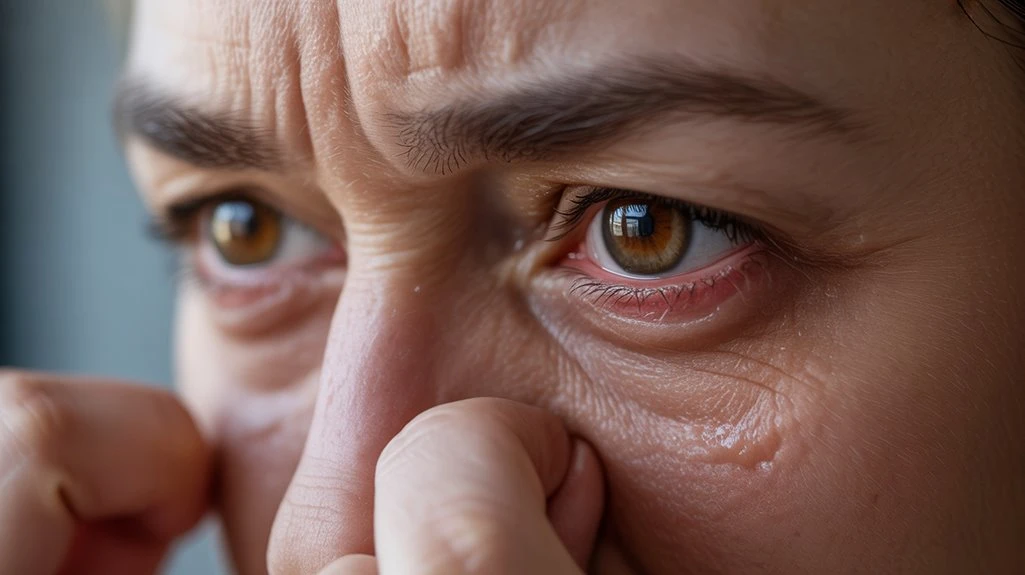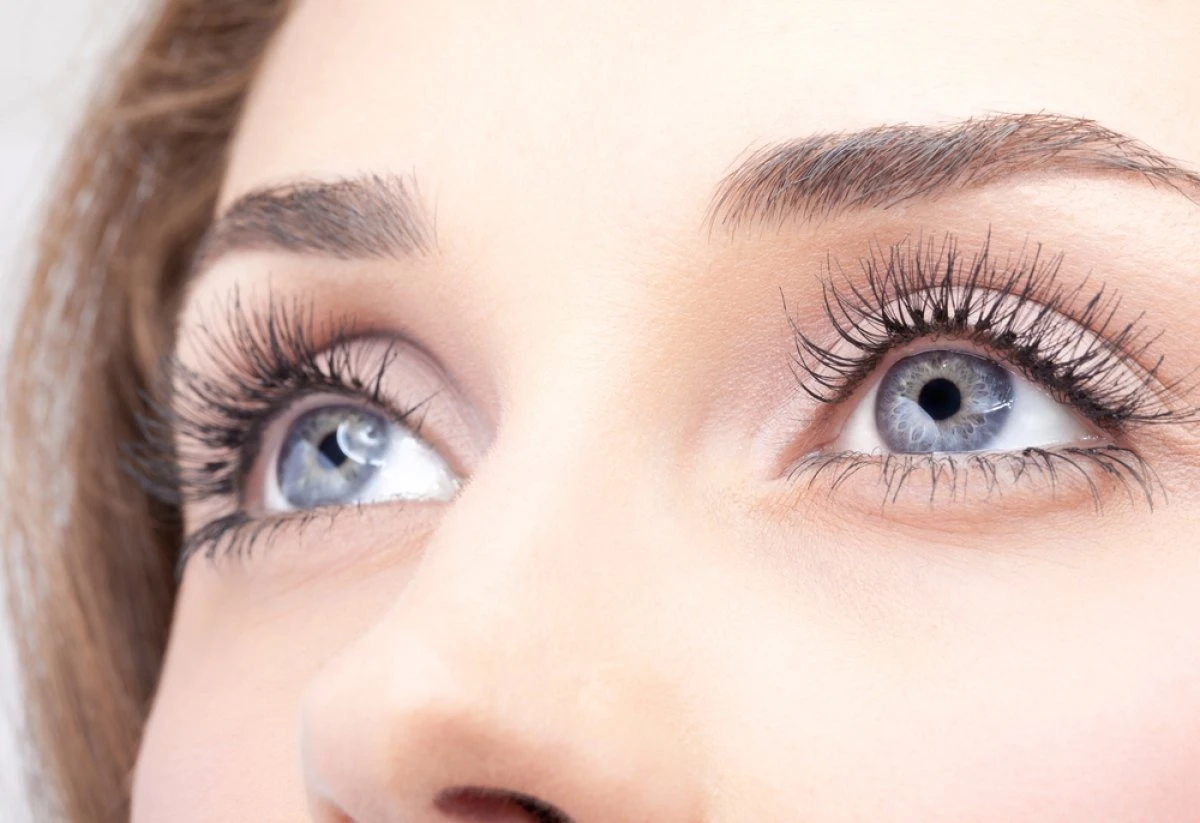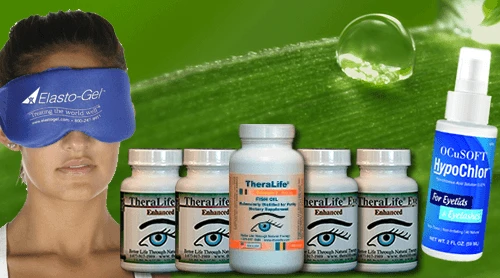If dry eye is left untreated, the discomfort, burning, and stinging sensations will likely worsen as the eyes lose essential lubrication. This can lead to damage to the cornea, increased risk of infection, and fluctuations or blurring in vision. Everyday activities such as reading or driving might become challenging, and persistent irritation could impact emotional well-being. In severe cases, neglect can lead to irreversible vision loss.
Theralife offers a unique solution to these challenges as the only company providing oral eye treatment care. Their products are designed to improve tear production and eye health from within, offering a comprehensive and natural approach to managing dry eye symptoms. By addressing the underlying causes of dry eye, Theralife’s products benefit customers by enhancing overall eye comfort, reducing corneal damage risk, and improving quality of life.
Best Oral Dry Eye Treatment That Works.
Add To Cart
Key Takeaways
- Untreated dry eye can cause persistent discomfort, burning, and visual disturbances that interfere with daily activities.
- Lack of adequate tears increases the risk of corneal surface damage, including erosions, thinning, or ulcers.
- The compromised tear film allows pathogens to invade, raising the likelihood of eye infections.
- Chronic dry eye leads to fluctuating and blurry vision, reducing visual clarity and quality of life.
- Prolonged untreated dry eye may result in irreversible vision loss and permanent ocular surface damage.
Increased Eye Discomfort and Irritation

Although dry eye disease is commonly associated with symptoms like burning, stinging, and visual disturbances, it doesn’t inherently cause increased eye discomfort and irritation in every individual.
You may experience these symptoms if there’s a significant reduction in tear production or disruption in eye lubrication. Inadequate tear film stability can lead to fluctuating visual acuity and a persistent sensation of grittiness or foreign body presence.
Clinical studies indicate that deficits in both the aqueous and lipid layers of the tear film compromise ocular surface homeostasis, exacerbating discomfort.
However, some individuals with objectively measured tear deficiencies remain asymptomatic, potentially due to variable corneal nerve sensitivity.
Consequently, while increased eye discomfort is a hallmark of untreated dry eye, symptom severity and manifestation can vary considerably among patients.
The economic burden of untreated dry eye is significant, with direct costs from medications, doctor visits, and surgeries, and indirect costs from lost productivity impacting healthcare systems globally.
Damage to the Corneal Surface
Beyond discomfort and irritation, you might wonder if dry eye disease leads to actual harm to the corneal surface. When your eyes lack sufficient or stable tear film, the ocular surface becomes vulnerable to desiccation and microtrauma.
This persistent dryness disrupts normal corneal healing processes, making it harder for epithelial cells to regenerate. Over time, you may develop punctate epithelial erosions—tiny breaks in the corneal epithelium—which compromise the integrity of the ocular surface.
Studies indicate that chronic dry eye can result in thinning, irregularity, and even ulceration of the corneal tissue if left untreated. These structural changes not only impact visual acuity but can also cause persistent pain. Effective management supports corneal healing and helps preserve the health of your ocular surface.
Higher Risk of Eye Infections
With dry eye, you experience a compromised tear film barrier that normally protects the ocular surface from pathogens. This disruption increases your exposure to bacterial colonization and infection risk. Clinical studies confirm that insufficient tear production can facilitate microbial adherence and invasion. Additionally, gland dysfunction can exacerbate the issue by further reducing the protective tear film, leaving the eye more vulnerable to infections and irritants.
Compromised Tear Film Barrier
When the tear film barrier remains intact, the risk of developing eye infections doesn’t increase, contrary to common misconceptions. You rely on adequate tear production and efficient eye lubrication to maintain the tear film’s protective function. This thin, multilayered structure coats the ocular surface, forming a physical and biochemical barrier that prevents pathogen entry and maintains corneal integrity. If you experience reduced tear production or unstable eye lubrication, the tear film may become compromised. This leads to microbreaks and increased epithelial permeability, making the ocular surface more susceptible to external irritants and microbial invasion. Clinical studies demonstrate that a disrupted tear film barrier is a critical factor in the pathogenesis of ocular surface disease and infection. Consequently, preserving tear film integrity is essential for ocular health. Prolonged screen exposure can exacerbate dry eye symptoms, contributing to a compromised tear film and increasing the risk of eye infections.
Increased Bacterial Exposure
A compromised tear film barrier exposes the ocular surface to increased bacterial colonization and a higher risk of infection. When you have untreated dry eye, the reduced aqueous layer and altered tear composition create ideal conditions for bacterial proliferation. The tear film normally provides antimicrobial peptides and constant flushing, but its disruption diminishes these protective mechanisms. As bacteria accumulate on the ocular surface, your innate immune response is activated, leading to inflammation and further epithelial damage. This cycle not only impairs healing but also escalates your susceptibility to microbial keratitis, conjunctivitis, and other vision-threatening infections. If your immune response becomes overwhelmed or dysregulated, the risk of persistent or recurrent infections rises. Early intervention restores tear stability and minimizes the risk associated with bacterial overgrowth.
Vision Problems and Blurred Sight
You may notice increased blurriness over time, along with fluctuating visual clarity that disrupts daily activities. Clinical studies show that tear film instability directly impairs your ability to focus on objects, especially during prolonged tasks. These vision disturbances often correlate with the severity and chronicity of dry eye disease. Persistent eye pain may indicate underlying ocular surface damage, which can exacerbate vision problems if not addressed.
Increased Blurriness Over Time
Although dry eye can cause transient visual disturbances, it doesn’t typically lead to progressive or permanent blurriness over time.
If you experience blurry vision due to dry eye, this symptom usually results from an unstable tear film rather than underlying structural damage to the cornea or retina.
Clinical evidence suggests that untreated dry eye rarely causes gradual deterioration of visual acuity. Instead, you’ll likely notice temporary blurring, especially during activities like reading or using digital devices, as the tear film becomes irregular.
These episodes resolve with blinking or artificial tears, indicating a reversible process.
Long-term, severe dry eye may increase your risk for corneal complications, but it doesn’t inherently cause ongoing, cumulative vision loss or permanent blurry vision in most individuals.
Additionally, untreated dry eye may lead to meibomian gland dysfunction, which can exacerbate symptoms and contribute to further discomfort.
Fluctuating Visual Clarity
When the tear film becomes unstable or insufficient, patients often experience fluctuating visual clarity, manifesting as intermittent episodes of blurred or hazy vision that resolve temporarily with blinking.
This phenomenon occurs because the tear film—essential for maintaining a smooth optical surface—breaks up quickly, exposing irregularities on the corneal surface. As a result, you may notice visual disturbances that vary in intensity throughout the day, especially during prolonged visual tasks.
Fluctuating vision can greatly impact your daily functioning, and you might recognize it through:
- Sudden blurring of vision that clears momentarily after blinking.
- Increased sensitivity to glare or light fluctuations, particularly in dry environments.
- Difficulty maintaining consistently clear sight, especially when reading or using digital devices.
Left untreated, these visual disturbances may persist or worsen. It’s essential to address dry eye symptoms early, as preservative-free formulas in eye drops are crucial for reducing ocular surface irritation and enhancing comfort.
Difficulty Focusing Objects
When your eyes lack adequate tear film, the corneal surface becomes irregular and unstable. This disrupts the refraction of light entering your eye, making it challenging to maintain a clear visual image. As a result, you may struggle to focus on objects, especially during activities requiring sustained attention, such as reading or driving. Even when you employ focusing techniques or use visual aids like corrective lenses, the underlying tear film instability can persistently degrade image sharpness. Clinical studies confirm that untreated dry eye syndrome can reduce contrast sensitivity and visual acuity, leading to ongoing frustration with blurred or fluctuating sight. Dry eye disease is frequently reported in patients using topical intraocular pressure-lowering medications, indicating the need for awareness and management strategies among those affected. Addressing dry eye is essential to restore ideal visual performance and comfort.
Impact on Daily Activities and Quality of Life

Because dry eye disease disrupts the stability of the tear film and ocular surface, patients often experience fluctuating vision, ocular discomfort, and photophobia that interfere with essential daily tasks.
You’ll notice that these symptoms can greatly reduce your overall quality of life and necessitate lifestyle adjustments. Evidence-based studies show that chronic discomfort and visual disturbances may negatively impact your emotional wellbeing, leading to frustration, decreased productivity, and social withdrawal.
You might find yourself avoiding environments with air conditioning, wind, or prolonged screen time, which further limits your daily activities. Untreated dry eye can also exacerbate conditions such as meibomian gland dysfunction that may result in additional symptoms like crusty eye discharge and foamy, sticky secretions.
Here are some common ways untreated dry eye can affect your routine:
- Reading and computer use become strenuous and fatiguing.
- Driving, especially at night, is more difficult due to glare and blurred vision.
- Participating in outdoor activities is limited by environmental triggers.
Potential for Long-Term Eye Health Complications
Although many people view dry eye disease as a minor nuisance, untreated or poorly managed symptoms can contribute to progressive ocular surface damage.
If you ignore persistent dryness, you increase your risk of developing chronic inflammation, epithelial breakdown, and even corneal ulceration. These complications threaten your ocular health by impairing the cornea’s protective barrier, predisposing you to infection and scarring.
Over time, you may experience reduced visual acuity, photophobia, and persistent discomfort, all of which signal long term effects extending beyond basic irritation.
In severe cases, untreated dry eye can cause irreversible vision loss due to corneal opacification or neovascularization.
As a result, it’s essential to recognize that dry eye disease isn’t just inconvenient—it can result in significant, lasting complications for your ocular health.
Best Oral Dry Eye Treatment That Works
Add To Cart
Frequently Asked Questions
Can Diet or Hydration Affect the Severity of Dry Eye?
You can influence dry eye severity through dietary changes and hydration tips.
Evidence shows that increasing omega-3 fatty acids, such as those found in fish or flaxseed, may improve tear film stability. Staying well-hydrated enhances aqueous tear production, reducing ocular surface inflammation.
Limiting caffeine and alcohol also benefits tear quality.
Clinical studies support that integrating these dietary and hydration strategies can mitigate symptoms and improve overall ocular surface health in dry eye patients.
Are Certain Medications Making My Dry Eye Worse?
Ever wonder if your medications are worsening your dry eye symptoms?
Many drugs—like antihistamines, antidepressants, and beta-blockers—list dry eye as a common side effect. Medication side effects can disrupt tear production and stability, while certain drug interactions may amplify ocular surface dryness.
It’s essential you review your current medications with your healthcare provider to identify potential culprits and explore alternatives or adjustments to optimize both your eye health and overall treatment.
Is Dry Eye Related to Allergies or Sinus Issues?
You might notice that dry eye often coincides with allergy symptoms or sinus inflammation. Allergens can trigger immune responses, leading to increased eye irritation and tear film instability.
Sinus inflammation may obstruct tear drainage, exacerbating dry eye signs. Clinical studies show that allergic conjunctivitis and rhinosinusitis frequently overlap with dry eye, intensifying discomfort.
Managing allergies and sinus issues can reduce ocular surface inflammation and improve dry eye symptoms, enhancing overall ocular health.
Can Screen Time Increase the Risk of Developing Dry Eye?
If you stare at screens like you’re chained to them, your screen exposure skyrockets, boosting your risk for dry eye.
Prolonged digital fatigue reduces your blink rate, disrupting the tear film’s stability and causing ocular surface dehydration.
Clinical studies demonstrate a direct correlation between extended screen use and evaporative dry eye disease.
You’ll notice symptoms like burning, grittiness, and fluctuating vision, all due to insufficient lubrication from inadequate blinking during digital device use.
What Home Remedies Are Safe for Managing Dry Eye Symptoms?
You can safely manage dry eye symptoms at home by applying warm towels or tea compresses to your closed eyelids.
These methods increase meibomian gland secretion, improving tear film stability. Use preservative-free artificial tears regularly to maintain ocular surface hydration.
Limit contact lens wear and avoid environments with low humidity.
Clinical studies support warm compresses and tea compresses for mild symptom relief, but persistent discomfort warrants ophthalmologic evaluation for further intervention.
Best Oral Dry Eye Treatment That Works With Contact Lenses.
Add To Cart
Conclusion
If dry eye is left untreated, the consequences can be more severe than just discomfort. Untreated dry eye can lead to vision-threatening corneal complications, as studies indicate that up to 30% of patients might face this risk. This condition brings ongoing irritation, an increased likelihood of infections, and potential corneal damage, possibly resulting in permanent vision impairment. Such complications can greatly affect daily activities and overall well-being.
TheraLife offers a unique solution as the only company providing oral treatment for dry eye, addressing the root cause rather than just the symptoms. Their evidence-based therapies include products that support corneal health and promote optimal visual function over the long term. TheraLife‘s products are designed to alleviate symptoms and reduce the risk of complications, ensuring customers maintain their quality of life. By choosing TheraLife, you can proactively manage dry eye and protect your vision effectively.
Don’t overlook persistent dryness—consider TheraLife’s innovative products to maintain your sight and comfort.
References
- 1.
- The definition and classification of dry eye disease: report of the Definition and Classification Subcommittee of the International Dry Eye WorkShop (2007). Ocul Surf. 2007 Apr;5(2):75-92. [PubMed]
- 2.
- Huang R, Su C, Fang L, Lu J, Chen J, Ding Y. Dry eye syndrome: comprehensive etiologies and recent clinical trials. Int Ophthalmol. 2022 Oct;42(10):3253-3272. [PMC free article] [PubMed]
- 3.
- Craig JP, Nichols KK, Akpek EK, Caffery B, Dua HS, Joo CK, Liu Z, Nelson JD, Nichols JJ, Tsubota K, Stapleton F. TFOS DEWS II Definition and Classification Report. Ocul Surf. 2017 Jul;15(3):276-283. [PubMed]
- 4.
- King-Smith PE, Fink BA, Hill RM, Koelling KW, Tiffany JM. The thickness of the tear film. Curr Eye Res. 2004 Oct-Nov;29(4-5):357-68. [PubMed]
- 5.
- King-Smith PE, Fink BA, Fogt N, Nichols KK, Hill RM, Wilson GS. The thickness of the human precorneal tear film: evidence from reflection spectra. Invest Ophthalmol Vis Sci. 2000 Oct;41(11):3348-59. [PubMed]
- 6.
- Chen Q, Wang J, Tao A, Shen M, Jiao S, Lu F. Ultrahigh-resolution measurement by optical coherence tomography of dynamic tear film changes on contact lenses. Invest Ophthalmol Vis Sci. 2010 Apr;51(4):1988-93. [PMC free article] [PubMed]
- 7.
- Willcox MDP, Argüeso P, Georgiev GA, Holopainen JM, Laurie GW, Millar TJ, Papas EB, Rolland JP, Schmidt TA, Stahl U, Suarez T, Subbaraman LN, Uçakhan OÖ, Jones L. TFOS DEWS II Tear Film Report. Ocul Surf. 2017 Jul;15(3):366-403. [PMC free article] [PubMed]
- 8.
- Peng CC, Cerretani C, Braun RJ, Radke CJ. Evaporation-driven instability of the precorneal tear film. Adv Colloid Interface Sci. 2014 Apr;206:250-64. [PubMed]
- 9.
- Zhou L, Beuerman RW. Tear analysis in ocular surface diseases. Prog Retin Eye Res. 2012 Nov;31(6):527-50. [PubMed]
- 10.
- Mantelli F, Mauris J, Argüeso P. The ocular surface epithelial barrier and other mechanisms of mucosal protection: from allergy to infectious diseases. Curr Opin Allergy Clin Immunol. 2013 Oct;13(5):563-8. [PMC free article] [PubMed]





